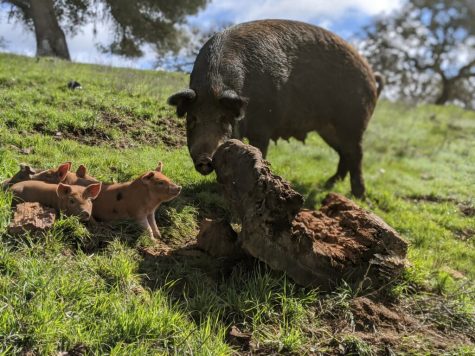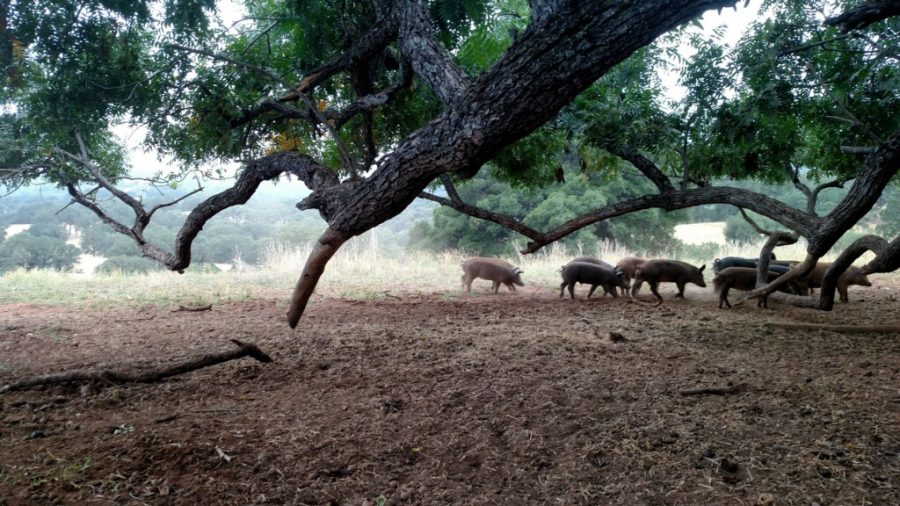Six million of them live in at least 35 states and cause $1.5 billion in property damage a year, according to the U.S. Department of Agriculture, and they are particularly infamous among Sonoma County vineyard owners. With titles of “hogacolypse,” “aporkolypse” and “feral swine bomb,” feral pigs are the animal many people think about when the name “invasive species” comes up.
Yet “invasive” is a subjective term that implies a species is an invader that can destroy whatever native habitats it comes across. Feral pigs have lived in California since the 1700s and now occupy 56 out of 58 counties, but have been so insubstantial that there are still no accurate population estimates for the state. They’ve been an established part of the ecosystem for some time without killing everything they’ve come across, so why are feral pigs considered such a problem now?
Meghan Walla-Murphy, a Santa Rosa Junior College natural resource management instructor and director of the North Bay Bear Collaborative, thinks “invasive” is an inaccurate descriptor for non-native species because it simplifies ecological processes and species competition — which are constantly changing — into what people like and don’t like. She thinks this applies to our use of the term for feral pigs, and she suggests we change the way we refer to the controversial species.
Walla-Murphy says invasive species are more accurately defined as “opportunistic species,” meaning they can survive in a variety of habitats and move into neighboring ecosystems when the opportunity arises. In the case of feral pigs, the opportunity for range expansion has all been human driven.
“A lot of people’s complaints about invasives are from a human-centric point of view and not really understanding their role in creating this imbalance within the ecology and ‘invasion,’” Walla-Murphy said.
When we call feral pigs invasive, we ignore the relationships they’ve made with other species in California and their role in the native ecology, she said.
For example, one role left open after Californians exterminated the California grizzly bear in the 1920s, was that of a large digging mammal that aided native plant propagation by mixing the soil.
“Grizzly bears are big diggers,” Walla-Murphy said. “If you go anywhere there are grizzlies left, like Yellowstone, you can see fields where they’ve turned over the soil looking for tubers or insects, and it looks similar to after a herd of pigs have moved through Sonoma County’s oak woodlands,”
Feral pig rooting also aids the Sonoma County ecosystem to resist the effects of man-made climate change, such as extreme droughts, she said, by allowing more water to enter the soil via aeration.
“When you see feral pigs in our oak woodlands, like around Lake Sonoma, they’re often rooting in contour,” she said of the pigs’ using their snouts to dig into the flat areas that ring hillsides. “So they create these micro-swales,” or depressions in the ridges, “and whenever it rains, water pools into these swales, which slows water runoff and increases ground percolation.”
Walla-Murphy said people only use the term invasive for species we don’t want in our space. An example of this is the non-native Broadleaf Plantain, which indigenous peoples heavily used as a powerful plant medicine but most modern farmers call a weed. She loves California’s native species, but said we can’t choose what’s best for our ecosystem based on what we like.
“When we have a non-native or even a native species that are encroaching or need some tending to, my question is, ‘How is a species functioning in the habitat or ecosystem, and do they need to be tended so that there’s more resiliency or biodiversity?’” Walla-Murphy said.
Another non-native flora that is vilified and targeted for removal, she said, is the French Broom plant, which is an important food source for native and non-native pollinators, like bees.
“If you rip it out, what are the results? Is it worth losing the pollinators that go with it?” Walla-Murphy said.
We run into a similar problem with feral hogs. Walla-Murphy said she commonly finds native species, such as Juncus and Sage and the native Foothill Yellow-legged Frog in swales created by feral pigs. If we wantonly kill feral pigs because we see them as invasive and nasty, we may also be removing habitats for native species and reducing biodiversity and resiliency.
Matt Nelson, owner of Redwood Coast Animal Tracking, has been hunting feral hogs all his life. He grew up in the hills of Annapolis among “poor country folk” who hunted feral hogs for food, and over time, he learned to respect them.
“They’re amazing, social, intelligent, affectionate, communicative animals. And I think it would benefit us if we looked at them in that way rather than [as] invasive vermin to be eradicated,” Nelson said.
He is writing a book about feral hogs, and after finishing his research has come to believe the pig problem is actually a human-driven problem.
“I traveled all over Texas for my research and spent a bunch of time on different ranches,” Nelson said. “What’s happening is hogs are expanding into these large, corporate farms. And the corporations don’t like that, so they’re spreading information and creating this attitude of war on pigs.”
According to Nelson’s review of the earliest written records kept on feral hog activity — records from Texas in the 1800s — feral hogs’ range was limited to land near human settlements, because they could not survive in the high desert without a water source. As colonists converted more and more land for agricultural purposes, thus expanding the hogs’ access to water, the species’ range expanded. Nelson said hunters have also purposely contributed to feral hog expansion by catching them and hauling them to new areas to populate new hunting grounds.
Feral hogs’ bad reputation is exaggerated or misleading, Nelson said. Other non-native species are more devastating to the ecosystem; domesticated cats kill a billion songbirds a year, and wild horses decimate native grasslands in the Southwest.
Nelson also thinks people blame feral hogs for destruction caused by preferred non-native species, like cows. While feral pig rooting disburses and aids the growth of new oak seedlings, cows love to eat baby oak trees, but people blame feral pigs for the decline of our oak woodlands.
Walla-Murphy said most of the complaints about feral pigs come from vineyard owners who don’t want pigs in their vines because they claim the pigs cause erosion, for example. However, the only places she’s seen feral pig activity lead to erosion and sedimentation into our water sources are places where the soil has already been disturbed, like in vineyards.

Rancher Kyle Farmer doesn’t hold any ill-will toward feral pigs, but his experience with their destructiveness makes him doubt their potential benefit. He joined his wife’s ranch, Magruder Ranch, in Potter Valley, California, in the middle of her family’s attempt to breed and tame 70 feral pigs of their own, but had to shut down the operation due to the pigs’ widespread destruction.
There was significantly less graze left to regrow in the pasture where they raised the pigs, he said.
A trend in California agriculture leverages indigenous and natural practices as a way to both honor the land and increase yield while regenerating the soil sans pesticides. In some cases, for example, grape growers who follow biodynamic practices use livestock to thin a cover crop and fertilize the land as they munch their way between rows of vines. But modern attempts at harnessing historical perspective while also trying to repurpose an invasive species are not always successful.
“Native people had a form of tending the land that was harvesting and redistribution and not taking the whole harvest. Feral pigs are not so cultured,” Farmer said. They disturb everything in their path.
Some disturbance to the ground is beneficial for the ecosystem, Nelson said, in agreement with Walla-Murphy’s bears-as-seed-sowers example. But too much disturbance is an environmental stressor that impedes growth and resiliency.
Nelson said there are a “ton of pigs” at the north end of Potter Valley, and since they have little pressure from predators, they have plenty of time to eat a mountain top clean.
While Farmer is hesitant to accept Walla-Murphy’s niche hogs-replace-bears theory, he did compare their destructiveness to the reintroduction of fire within Sonoma County in that they’ve both been mismanaged for so long they’ve gotten beyond human control.
Currently, there’s no such thing as successful management of feral hogs, Farmer said, and any perceived success is merely an illusion until they adapt and become a problem again. However, he thinks hunting could be beneficial for other reasons.
“They’re easy to find, available year round, and it’s a sustainable yield of meat coming out of the hills. You can’t beat it,” Farmer said. “They’re also a great animal to learn to hunt from. I guide people hunting elk, and it’d be a lot better if they had been starting out with pig hunting.”
Walla-Murphy thinks hunting would help manage feral pigs.
“I was taught an invasive species doesn’t play well with others and kind of needs some boundaries put in it,” she said. “I believe they need to be hunted to be kept in check.”
Some in the California statehouse agree. In January 2022, State Sen. Bill Dodd introduced legislation aimed at increasing feral pig hunting by replacing $15 per-pig kill tags with a $15 flat fee for a season-long pig hunting license.
“We must increase opportunities to hunt them so that we may bring our pig population under control,” Sen. Dodd said in a press release.
Critics say that since the bill doesn’t also change the range where pig hunting is acceptable, these intelligent animals will simply learn to congregate in areas where they can’t be hunted.
The bill will also not have much effect on the amount of hunting. According to the State of California and Wildlife Wild Pig Take Report, 53,923 tags to hunt feral pigs were purchased yet only 3,950 feral pigs were reported taken in the 2020-2021 season. Of all the feral hogs taken, 90.4% were hunted on private land where hunters are required to have the owner’s permission to hunt and will usually have to pay the owner an extra fee anyway.
Simply reducing the price to hunt feral hogs also promotes the reckless killing that can damage native habitats, which Walla-Murphy warned about. Feral pigs are thriving in California because they’ve developed a relationship with the existing flora and fauna. If humans want to minimize their feral pig problems, they need to respect their role in the ecosystem.
“We’re not getting rid of feral pigs, period. So given that, then how do we come into a good relationship with them?” Walla-Murphy said. “All things need boundaries, including humans.”




